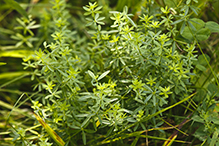shining bedstraw
(Galium concinnum)
Conservation • Wetland • Description • Habitat • Ecology • Use • Distribution • Taxonomy
Description |
||
Shining bedstraw is a 5″ to 24″ long, erect or sprawling, perennial forb that rises on multiple stems from shallow roots. The stems are spreading or ascending, slender, weak, 4-angled, hollow, and much branched. The angles often rough with sparse, short, stiff, downward-pointing hairs. They do not have hooked hairs. The main leaves are small, stalkless, and in whorls of 6. On the branches the leaves are in whorls of 4. The blades are linear or linear elliptic, ⅜″ to ¾″ long, and 3 ⁄32″ to 5 ⁄32″ wide. They have a single prominent vein running from the base to the tip. There is an abrupt, short, sharp, firm point at the tip. The margins are untoothed and rough with short, stiff, forward-pointing hairs. They do not have hooked hairs. The inflorescences are clusters of several to many flowers at the ends of stems and branches and rising from upper leaf axils. The clusters are forked 2 or 3 times, the forks widely spreading. The flowers are ⅛″ or less wide. They consist of 4 short, white petals with pointed tips, 4 sepals that are shorter than the petals, 4 short stamens, and 2 short, pale yellow styles. There are 2 carpels at the base of the flower. The carpels are green and are joined together. They are not covered with hooked hairs. The fruit is a green, hairless, ball-like, 1-seeded capsule, joined in pairs. |
||
Height |
||
5″ to 24″ long |
||
Flower Color |
||
White to cream |
||
Similar Species |
||
False baby’s breath (Galium mollugo) stems are usually erect. Sometimes the stems are stunted or poorly developed due to environmental conditions, and may be mistaken for shining bedstraw. However, the former has whorls of 8 to 12 leaves at the main nodes. Northern bedstraw (Galium boreale) sometimes has leaves as small as shining bedstraw. However, the leaves of the former are blunt-tipped and always in whorls of 4. |
||
Habitat |
||
Dry to moist. Woods. Partial shade. |
||
Ecology |
||
Flowering |
||
June to August |
||
Pests and Diseases |
||
|
||
Use |
||
|
||
Distribution |
||||
|
Sources |
|||
| 3/24/2023 | ||||
Nativity |
||||
Native |
||||
Occurrence |
||||
|
||||
Taxonomy |
|||
| Kingdom | Plantae (Plants) | ||
| Division | Tracheophyta (Vascular Plants) | ||
| Subdivision | Spermatophytina (Seed Plants) | ||
| Class | Magnoliopsida (Dicots) | ||
Order |
Gentianales (Gentians, Dogbanes, Madders, and Allies) | ||
Family |
Rubiaceae (madder) | ||
| Subfamily | Rubioideae | ||
| Tribe | Rubieae | ||
Genus |
Galium (bedstraws) | ||
Subordinate Taxa |
|||
|
|||
Synonyms |
|||
|
|||
Common Names |
|||
pretty bedstraw shining bedstraw |
|||
Glossary
Axil
The upper angle where a branch, stem, leaf stalk, or vein diverges.
Carpel
The female reproductive organ of a flower, consisting of an ovary, styles, and stigmas.
Sepal
An outer floral leaf, usually green but sometimes colored, at the base of a flower.
Visitor Photos |
|||||
Share your photo of this plant. |
|||||
| This button not working for you? Simply email us at info@MinnesotaSeasons.com. Attach one or more photos and, if you like, a caption. |
|||||
|
|||||
MinnesotaSeasons.com Photos |
|||||
 |
 |
||||
 |
|||||

Slideshows |
||

Visitor Videos |
|||
Share your video of this plant. |
|||
| This button not working for you? Simply email us at info@MinnesotaSeasons.com. Attach a video, a YouTube link, or a cloud storage link. |
|||
Other Videos |
|||

Visitor Sightings |
|||||
Report a sighting of this plant. |
|||||
| This button not working for you? Simply email us at info@MinnesotaSeasons.com. Be sure to include a location. |
|||||
|
|||||
MinnesotaSeasons.com Sightings |
|||||

|
Created: Last Updated: © MinnesotaSeasons.com. All rights reserved. |
